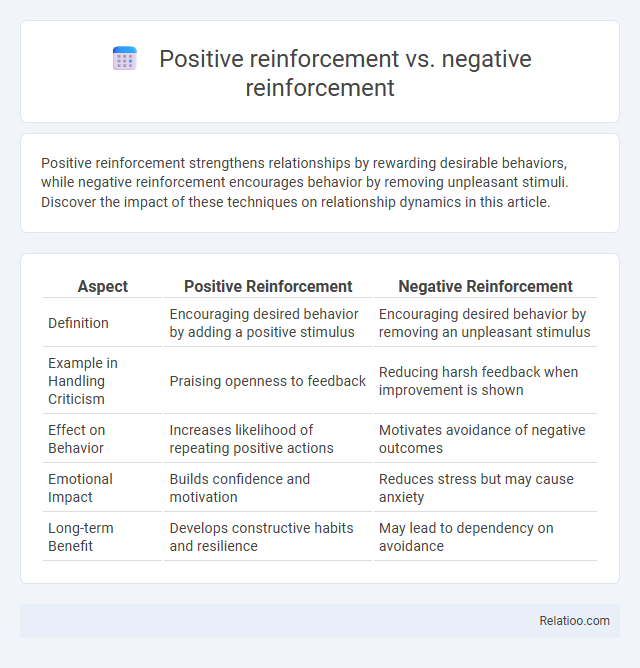Positive reinforcement strengthens relationships by rewarding desirable behaviors, while negative reinforcement encourages behavior by removing unpleasant stimuli. Discover the impact of these techniques on relationship dynamics in this article.
Table of Comparison
| Aspect | Positive Reinforcement | Negative Reinforcement |
|---|---|---|
| Definition | Encouraging desired behavior by adding a positive stimulus | Encouraging desired behavior by removing an unpleasant stimulus |
| Example in Handling Criticism | Praising openness to feedback | Reducing harsh feedback when improvement is shown |
| Effect on Behavior | Increases likelihood of repeating positive actions | Motivates avoidance of negative outcomes |
| Emotional Impact | Builds confidence and motivation | Reduces stress but may cause anxiety |
| Long-term Benefit | Develops constructive habits and resilience | May lead to dependency on avoidance |
Understanding Positive Reinforcement
Positive reinforcement involves adding a rewarding stimulus after a desired behavior to increase its occurrence, such as giving praise or treats. Negative reinforcement strengthens behavior by removing an unpleasant stimulus when the desired action occurs, like turning off a loud noise once a task is completed. Understanding positive reinforcement is crucial for effective behavior modification because it encourages repetition of positive actions through motivating rewards.
Understanding Negative Reinforcement
Negative reinforcement strengthens behavior by removing an unpleasant stimulus when the desired action occurs, helping You learn through relief rather than punishment. Unlike positive reinforcement, which adds a rewarding stimulus to encourage behavior, negative reinforcement involves eliminating discomfort to increase the likelihood of repetition. Understanding negative reinforcement is crucial for applying behavior modification techniques effectively and improving motivation in various settings.
Key Differences Between Positive and Negative Reinforcement
Positive reinforcement involves adding a desirable stimulus to increase a behavior, such as giving praise or rewards, while negative reinforcement entails removing an aversive stimulus to encourage behavior, like turning off a loud noise when a task is completed. Both methods aim to strengthen behavior, but positive reinforcement focuses on introducing positive outcomes, whereas negative reinforcement relies on eliminating unpleasant conditions. Understanding these key differences helps in designing effective behavioral interventions in educational and clinical settings.
How Positive Reinforcement Shapes Behavior
Positive reinforcement shapes behavior by introducing rewarding stimuli immediately after a desired action, increasing the likelihood of that behavior recurring. Unlike negative reinforcement, which strengthens behavior by removing unpleasant stimuli, positive reinforcement encourages repeat actions through positive rewards such as praise, treats, or bonuses. Your consistent use of positive reinforcement creates a motivating environment that supports sustained behavioral changes effectively.
The Role of Negative Reinforcement in Behavior Modification
Negative reinforcement strengthens behavior by removing or avoiding unpleasant stimuli, encouraging Your repeated actions to prevent discomfort. Unlike positive reinforcement, which adds rewards, and punishment, which introduces adverse consequences, negative reinforcement emphasizes relief from negative conditions to modify behavior effectively. This mechanism plays a critical role in behavior modification by promoting adaptive behaviors through the elimination of unwanted experiences.
Benefits of Positive Reinforcement
Positive reinforcement enhances learning and behavior by rewarding desired actions, leading to increased motivation and long-term habit formation. Unlike negative reinforcement, which involves the removal of unpleasant stimuli, positive reinforcement creates a positive association, fostering a supportive and encouraging environment. Studies show that positive reinforcement improves employee performance, boosts self-esteem, and strengthens relationships across educational and workplace settings.
Potential Drawbacks of Negative Reinforcement
Negative reinforcement involves removing an aversive stimulus to increase desired behavior, which can inadvertently encourage avoidance rather than genuine learning. This method risks creating anxiety or stress as individuals may focus on escaping discomfort rather than understanding appropriate behavior. Unlike positive reinforcement, which adds rewarding stimuli to strengthen behavior, negative reinforcement can sometimes reinforce unwanted behaviors due to its reliance on discomfort.
Real-World Examples: Positive vs Negative Reinforcement
Positive reinforcement involves adding a desirable stimulus to increase behavior, such as giving your child praise or rewards for completing homework. Negative reinforcement entails removing an unpleasant stimulus to encourage behavior, like turning off a loud alarm when you fasten your seatbelt. Real-world examples highlight that positive reinforcement often creates longer-lasting motivation, while negative reinforcement primarily drives behavior through relief from discomfort.
Choosing the Right Reinforcement Strategy
Choosing the right reinforcement strategy depends on your specific goals and the behavior you want to encourage or discourage. Positive reinforcement involves adding a rewarding stimulus to increase desired behavior, while negative reinforcement removes an unpleasant stimulus to strengthen behavior. Understanding the context and individual preferences helps ensure your reinforcement approach effectively motivates and shapes behavior for optimal results.
Tips for Effectively Implementing Reinforcement Techniques
To effectively implement reinforcement techniques, clearly identify the specific behavior you want to encourage or discourage, using positive reinforcement by rewarding desired actions to strengthen them. Negative reinforcement involves removing an unpleasant stimulus when the desired behavior occurs, while punishment aims to weaken unwanted behavior, requiring careful consideration to avoid adverse effects. You can maximize behavior change by consistently applying reinforcement immediately after the behavior and ensuring rewards or consequences are meaningful to the individual.

Infographic: Positive reinforcement vs Negative reinforcement
 relatioo.com
relatioo.com